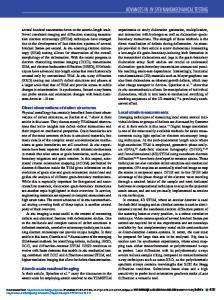Nanomechanical testing for fracture of oxide films
- PDF / 2,125,788 Bytes
- 8 Pages / 612 x 792 pts (letter) Page_size
- 95 Downloads / 297 Views
The mechanical properties of thermally grown oxide films on various aluminum substrates were tested using nanoindentation. A sudden discontinuity, indicative of film fracture, was observed upon loading portion of the load–depth curve. The 63-nm-thick films were determined to have ultimate strengths between 4.8 and 8.9 GPa. The ultimate stress is a superposition of the bending and membrane stress. The stress intensity at fracture for each of the films was developed by approximating the resulting bending moment and various cracks sizes. At a constant ratio of crack size to oxide thickness of 0.3, the applied stress intensity at fracture of these aluminum oxide films were between 0.46 and 1.20 MPa m1/2. The residual stress in the film was assumed to be negligible in the stress intensity calculation.
I. INTRODUCTION
Many metals, such as aluminum and titanium, form native oxides on the surface. In turn, these oxides enhance protection of the underlying metal against wear and corrosion. The mechanical integrity of these protective oxides needs to be characterized to increase protection against harsh environments. Improving the mechanical properties will lead to better product quality and a longer lifetime. Nanoindentation has been used to study the mechanical response of various metal/ oxide systems.1,2 During the loading of these systems, a sudden discontinuity has been observed. In some cases, the sudden discontinuity has been attributed to yielding and nucleation of dislocations in the substrate,3,4 and other cases have shown that it was caused by film fracture.1,2,5–7 Previous studies have demonstrated via atomic force microscopy, electron microscopy, or optical microscopy that a film fracture event generates a circumferential crack around the indentation in the oxide film.2,8,9 Chechinen and co-workers studied the critical load and depth of the discontinuity during indentation for an Al2O3/Al system as a function of film thickness.1 They showed that both the critical load and depth for thicker films followed a Weibull type distribution with parameters typical to materials with moderate brittleness and hardness. A model was developed to describe the critical parameters for load and depth. The model was in good
a)
Address all correspondence to this author. e-mail: [email protected] DOI: 10.1557/JMR.2005.0188 1490
http://journals.cambridge.org
J. Mater. Res., Vol. 20, No. 6, Jun 2005 Downloaded: 16 Mar 2015
agreement for thicker films, but some deviation occurred for thinner films. Another way to quantify film fracture is to determine the radial stress as a function of contact load needed for failure. Various analytical methods have been used to model the system.10,11 One method was to model the film as an axisymmetric circular plate with clamped edges supported on a compliant foundation.2,6,7 Pang and Bahr used nanoindentation to test an anodically grown TiO2 film on a mechanically polished Ti substrate.2 This system exhibited plastic deformation prior to the load at which the discontinuity was seen, which indic
Data Loading...










